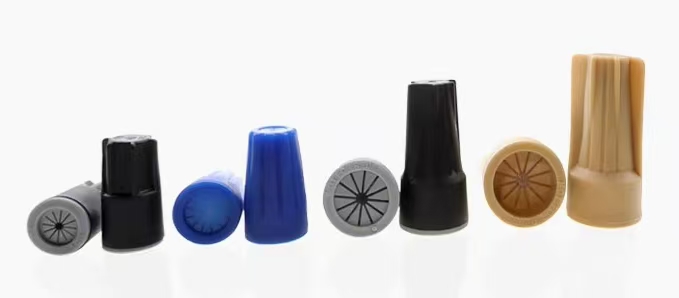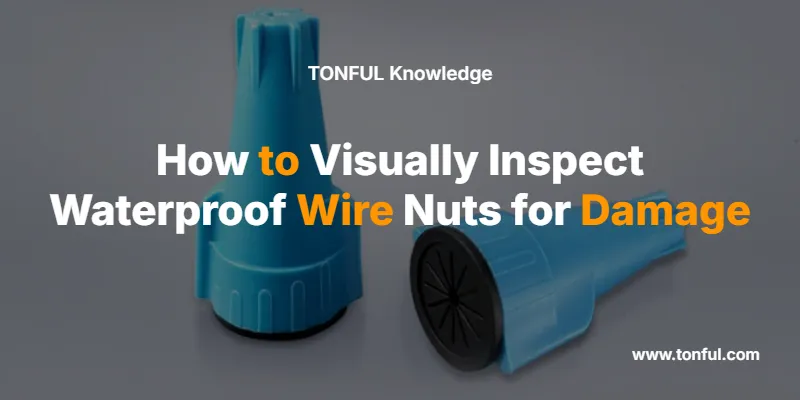You can visually inspect waterproof wire nuts for damage by examining the silicone seal for cracks or tears, checking for discoloration or melting, looking for visible corrosion on metal components, and testing the physical integrity of the connector body. A damaged waterproof wire nut compromises electrical safety and can lead to short circuits, water infiltration, and fire hazards.
Understanding how to properly inspect these critical electrical components protects your home, ensures code compliance, and prevents costly electrical failures in outdoor and wet-location installations.
What Are Waterproof Wire Nuts?

Waterproof wire nuts are specialized electrical connectors designed to join wires while providing protection against moisture infiltration. Unlike standard wire nuts, they feature integrated silicone or gel-filled seals that create a watertight barrier around wire connections.
These connectors are essential for outdoor lighting, landscape installations, pool equipment, irrigation systems, and any electrical application exposed to moisture or wet conditions. The National Electrical Code (NEC) Article 110.11 requires that equipment exposed to weather be listed and identified as suitable for wet locations.
Key Differences: Waterproof vs Standard Wire Nuts
Here is a table that shows the critical differences between waterproof and standard wire nuts:
| Feature | Standard Wire Nuts | Waterproof Wire Nuts |
|---|---|---|
| Moisture Protection | None – indoor use only | Silicone/gel seal creates watertight barrier |
| Installation Environment | Dry locations only | Wet locations, direct burial, outdoor use |
| Seal Material | Plastic shell only | Integrated silicone or dielectric gel |
| NEC Compliance | Article 110.14 (general) | Article 110.11 (wet location listing) |
| Price Range | $0.10-$0.30 per connector | $0.50-$2.00 per connector |
| Inspection Requirements | Visual check for cracks | Seal integrity + full visual inspection |
| Typical Applications | Interior wiring, junction boxes | Outdoor lighting, landscape, pool equipment |
| Expected Lifespan | 20+ years (protected) | 10-15 years (exposed to elements) |
7-Step Visual Inspection Process
Follow this systematic inspection process to identify damage before electrical failure occurs:
Step 1: Power Down and Verify
Turn off power at the circuit breaker and use a non-contact voltage tester to verify the circuit is de-energized. Never inspect connections under live power conditions.
Step 2: Examine the Silicone Seal
Look closely at the silicone or gel-filled cap for these critical damage indicators:
- Cracks or splits in the silicone material
- Tears at stress points where wires enter
- Hardening or brittleness from UV exposure
- Missing or displaced gel fill
Step 3: Check for Discoloration
Inspect the entire connector body for heat damage signs:
- Brown or black scorching marks
- Yellow discoloration indicating overheating
- Melted or deformed plastic components
- Bubbling or warping of the connector shell
Step 4: Look for Physical Damage
Examine the structural integrity of the connector:
- Cracks in the plastic housing
- Broken or missing components
- Loose or separated wire connections
- Impact damage or crushing
Step 5: Inspect for Corrosion
Check visible metal parts for moisture infiltration:
- Green or white corrosion on copper conductors
- Rust or oxidation on connection points
- Water stains or mineral deposits
- Moisture inside the connector housing
Step 6: Test Physical Security
Gently test the connection without pulling wires:
- Verify the connector is firmly seated
- Check that wires cannot be pulled free
- Ensure no wire movement inside the connector
- Confirm proper wire insertion depth
Step 7: Document Your Findings
Record inspection results with photos and notes:
- Date of inspection
- Location of each connector
- Condition assessment (pass/fail/monitor)
- Replacement schedule for marginal connectors
Critical Damage Indicators Requiring Immediate Replacement
Here is a table that shows damage types and their risk levels:
| Damage Type | Risk Level | Action Required | Failure Risk |
|---|---|---|---|
| Cracked silicone seal | HIGH | Replace immediately | Water infiltration within days |
| Visible corrosion | HIGH | Replace immediately | Connection failure imminent |
| Melting or discoloration | CRITICAL | Replace + investigate cause | Fire hazard – immediate danger |
| Loose wire connection | HIGH | Replace immediately | Arcing and overheating risk |
| Hardened/brittle seal | MEDIUM | Replace within 30 days | Seal failure pending |
| Minor surface scratches | LOW | Monitor next inspection | Cosmetic only |
| Slight discoloration | MEDIUM | Replace within 90 days | Early heat damage indicator |
| Missing gel fill | HIGH | Replace immediately | No moisture protection |
SAFETY WARNING: Any connector showing melting, charring, or severe heat damage indicates a serious electrical problem. Replace the connector immediately and investigate the root cause – oversized load, loose connection, or circuit overload. Consult a licensed electrician if the cause is unclear.
What Causes Waterproof Wire Nut Damage?
Understanding failure causes helps you prevent future problems:
UV Degradation
Direct sunlight breaks down silicone materials over 5-10 years, causing hardening and cracking. UV-resistant connectors rated for direct sunlight exposure last significantly longer.
Thermal Cycling
Repeated heating and cooling from temperature changes causes expansion and contraction, eventually cracking seals and loosening connections. This accelerates in extreme climates.
Mechanical Stress
Physical impact, excessive wire movement, or improper installation techniques can crack housings and tear seals at wire entry points.
Chemical Exposure
Pool chemicals, fertilizers, pesticides, and other outdoor substances can degrade silicone seals and plastic housings over time.
Improper Installation
Insufficient wire insertion, wrong connector size for wire gauge, or failure to twist wires properly before installing the connector leads to loose connections and overheating.
Expert Inspection Tips
Tip #1: Use a Flashlight for Detail Inspection
A bright LED flashlight held at an angle reveals cracks and damage invisible in normal lighting. Inspect from multiple angles.
Tip #2: Feel for Seal Integrity
Gently squeeze the silicone seal with your fingers. It should feel pliable and soft. Hardness or brittleness indicates UV damage and pending failure.
Tip #3: Check Twice Per Year Minimum
Inspect outdoor electrical connections in spring and fall. Seasonal temperature extremes cause the most damage during winter and summer months.
Tip #4: Mark Inspection Dates
Use a permanent marker to write installation dates on white wire nut caps, making it easy to track age and replacement schedules.
Tip #5: Replace Before Complete Failure
Don’t wait for obvious failure. Replace connectors showing any damage indicators during routine inspection to prevent emergency repairs.
Waterproof Wire Nut Specifications and Ratings
Here is a table that shows common specifications you should understand:
| Specification | What It Means | Why It Matters |
|---|---|---|
| Wire Gauge Range | 22 AWG – 10 AWG typical | Wrong size = loose connection |
| Voltage Rating | 600V standard | Must meet circuit voltage |
| Temperature Rating | -40°F to 221°F typical | Ensures performance in extremes |
| IP Rating | IP67 or IP68 (submersion) | Defines water protection level |
| UL Listing | UL 486C (wire connectors) | Required for code compliance |
| Direct Burial Rating | DB or underground rated | Needed for buried applications |
| UV Resistance | Sunlight rated or not | Critical for exposed installations |
| Fill Material | Silicone gel or grease | Provides moisture barrier |
EXPERT TIP: Always verify that replacement connectors meet or exceed the IP rating and certifications of the original. Using standard wire nuts in wet locations violates NEC Article 110.11 and creates serious safety hazards.
When to Call a Professional Electrician
You should consult a licensed electrician in these situations:
Repeated Connector Failures
If connectors in the same location fail repeatedly, an underlying electrical problem exists that requires professional diagnosis.
Signs of Overheating
Melted connectors, discolored wiring, or scorching indicates potentially dangerous circuit overload or connection problems.
Buried or Inaccessible Connections
Direct burial applications require special connectors and installation techniques. Improper burial installation causes moisture infiltration and costly failures.
High-Voltage Applications
Circuits over 120V, especially 240V pool and spa equipment, require professional installation and inspection for safety and code compliance.
Uncertainty About Code Compliance
Local electrical codes vary by jurisdiction. When in doubt about requirements, consult a professional before making repairs or modifications.
Quick Reference Inspection Checklist
Use this checklist during your visual inspections:
- Power verified OFF with voltage tester
- Silicone seal intact with no cracks or tears
- No discoloration, melting, or scorching
- No visible corrosion on conductors
- Connector housing undamaged and intact
- Wires securely held – no movement when gently tested
- Gel fill present and properly sealing wires
- No moisture, water stains, or mineral deposits
- Connection date marked and within service life
- Inspection results documented with photos
SAFETY WARNING: Always work with power OFF. Use a non-contact voltage tester to verify circuits are de-energized. Wet location electrical work presents shock and electrocution hazards. When in doubt, hire a licensed electrician.
Frequently Asked Questions
How often should you inspect waterproof wire nuts?
You should inspect waterproof wire nuts twice per year minimum – once in spring and once in fall. Inspect more frequently in harsh climates or high-moisture environments like pool equipment areas. Any time you notice outdoor lighting flickering or electrical equipment malfunctions, perform an immediate inspection.
Can you reuse waterproof wire nuts after inspection?
You should never reuse waterproof wire nuts once removed. The silicone seal and gel fill lose their integrity when disturbed, eliminating moisture protection. Always use new connectors when making any changes to wiring connections.
What does a properly installed waterproof wire nut look like?
A properly installed waterproof wire nut shows no gaps between the silicone seal and wires, with the gel fill completely surrounding conductors. The cap sits firmly with no visible wire strands outside the connector, and wires cannot be pulled free with reasonable force. You should see no discoloration, and the silicone remains soft and pliable.
Do waterproof wire nuts expire?
While waterproof wire nuts don’t have official expiration dates, their effective service life is 10-15 years in outdoor applications. UV exposure, temperature cycling, and environmental factors degrade sealing materials over time. Replace connectors proactively based on age and condition rather than waiting for failure.
Are waterproof wire nuts required by code for outdoor lighting?
Yes, the National Electrical Code (NEC) Article 110.11 requires equipment exposed to weather to be listed and identified as suitable for wet locations. Standard wire nuts are not code-compliant for outdoor applications. Use only UL-listed waterproof connectors rated for wet locations or direct burial as applicable.
What’s the difference between water-resistant and waterproof wire nuts?
Water-resistant connectors provide splash protection but not submersion protection, typically rated IP65. Waterproof connectors are rated IP67 (temporary submersion) or IP68 (continuous submersion). For outdoor applications, use IP67 minimum. For direct burial or areas with standing water, use IP68-rated connectors.
Can you use waterproof wire nuts in junction boxes?
Yes, you can use waterproof wire nuts inside junction boxes, and they’re required when the junction box is installed in a wet location. However, the junction box itself must also be rated for wet locations with appropriate gaskets and covers to meet code requirements.
How do you know if a waterproof wire nut has failed?
Failed waterproof wire nuts show visible corrosion on conductors, moisture inside the housing, cracked or hardened seals, or intermittent electrical operation. You may notice outdoor lights flickering, dimming, or failing completely. Physical inspection reveals water stains, mineral deposits, or green corrosion indicating moisture infiltration.
Making the Right Choice for Electrical Safety
Regular visual inspection of waterproof wire nuts is a critical maintenance task that prevents electrical failures, protects your property, and ensures the safety of your outdoor electrical systems. By following the systematic 7-step inspection process, recognizing critical damage indicators, and replacing compromised connectors proactively, you maintain reliable electrical connections in wet locations.
Remember that electrical safety is never optional. When inspecting waterproof wire nuts, always work with power OFF, follow NEC guidelines, and don’t hesitate to consult a licensed electrician for complex issues or repeated failures. Your investment in regular inspection prevents costly emergency repairs and eliminates dangerous electrical hazards.
Document your inspections, maintain a replacement schedule, and use only UL-listed connectors appropriate for your specific application. Quality waterproof wire nuts installed correctly and inspected regularly provide decades of safe, reliable service in even the most challenging outdoor environments.

